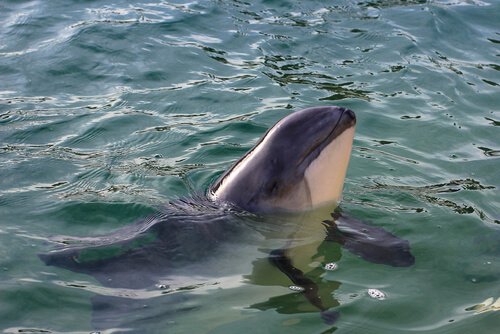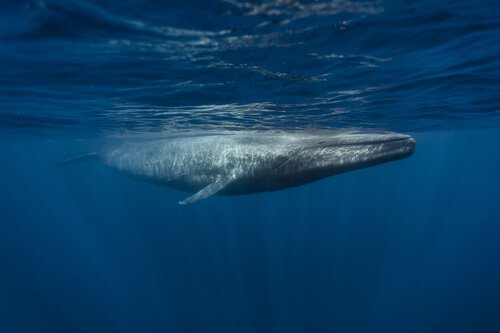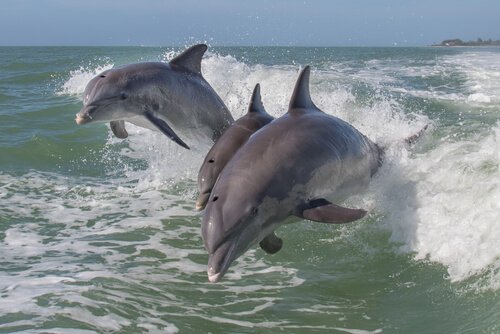How are cetaceans classified and what are they?
The classification of cetaceans is an area of study to which many scientists have been dedicated for a long time . Due to their curious morphological and physiological characteristics, the cetaceans have captivated many researchers.
Perhaps the most important feature of cetaceans is that they are eutherian aquatic mammals . The eutherian mammals are all those mammals that possess placenta. This feature is very rare in marine animals.
The name cetacean comes from the Greek ketos, which meant sea monster . For Aristotle, responsible for coining the term, whales were monstrous animals.
According to the Greeks, ketos were those marine animals with the capacity of lung breathing. Thus, although the cetaceans are completely adapted to the marine environment, they can not get oxygen from the water . To breathe, all cetaceans must come to the surface.
Cetaceans are animals of different sizes . Some, like porpoises, are small in size. However, many species of cetaceans have a huge size, as is the case with sperm whales.

Cetaceans evolved from being semi-aquatic animals to being marine animals . As it happened in the otaridos, the front legs evolved in fins. Over time, the back of their bodies was transformed into a horizontal caudal fin.
The horizontal orientation of their caudal fin allows them to swim to the surface more easily. In general, ketos have one or two holes in the upper part of their bodies through which they breathe.
According to their morphological characteristics, Cetacea are organized in different species. If you want to know how to classify cetaceans, this article is for you.
How are cetaceans classified?
Within the family of cetaceans have been classified three suborders . These suborders are archaeocetes, mysticetes and odontocetes. The archaeocetes are those species of cetaceans already extinct.
The suborder of cetaceans mystatus is made up of the baleen whales . Mysticetes group some of the largest animals in the world, such as whales and fin whales.
Mysticetes are four families of carnivorous cetaceans, although their jaws do not have teeth. This class of animals have strong keratin beards in the upper jaw. These beards help to filter the water that comes out of their mouth: they trap inside it the living beings they feed on.
The bodies of these Cetacea they resist to very low temperatures, due to the thick layer of fat under their skin. In addition, their lungs have an oxygen capacity of 80%.

The third suborder of cetaceans are the odontocetes, also known as dentate cetaceans . As the name suggests, this class is characterized by having a jagged mouth.
Unlike the huge mysticetes, the odontocetes are of very different sizes. The size of the odontocetes goes from dolphins, killer whales and sperm whales to small porpoises and sea cows . In general, it is easy to identify the odontocetes, since they all have a dorsal fin.
A curious characteristic of the odontocetes is their bulging forehead, under which an extraordinary organ is found.When the sound waves return, the melon perceives the location of the objects that surround it. For this reason it is called echolocation.
From whales to dolphins: species of cetaceans
There are many species within the classification of cetaceans . Among these species are the whales, the yubartas, the marine and river dolphins, the porpoises, the sperm whales, the beaked whales and the belugas.
The whales are classified into three families: the balénidos, the escríctidos and the neobalénidos . The three families are characterized by understanding large and longevity specimens.
Whales can live more than 30 years and measure, on average, 5 to 17 meters long . In addition, a whale can weigh more than 80 tons.
However, the fin whales are even bigger than the whales. A fin whale can measure up to 35 meters long and weigh more than 170 tonnes . The folds of your throat can expand to store up to 90 tons of water. Only in this way can they consume enough krill .

Perhaps the most common species of Ceatacea are oceanic dolphins . Among these dolphins are the orcas, known for their violence and rapidity in the waters. The size of the dolphins varies between two and nine meters, and their bodies have evolved to reach great speed.
All dolphins, being odontocetes, possess the organ melon for echolocation
strong>. For this reason, dolphins are characterized by bulging foreheads. Dolphins are extremely intelligent animals, with a lot of gray matter.There are many other species of ketos in the world. However, in recent years this family has faced a serious decline in their numbers.
Although there are many international measures to protect different species, these animals are still in danger of extinction. Whaling is a common practice in many countries, although little by little it has diminished.
It is expected that in the coming years the number of cetaceans in danger will decrease.


